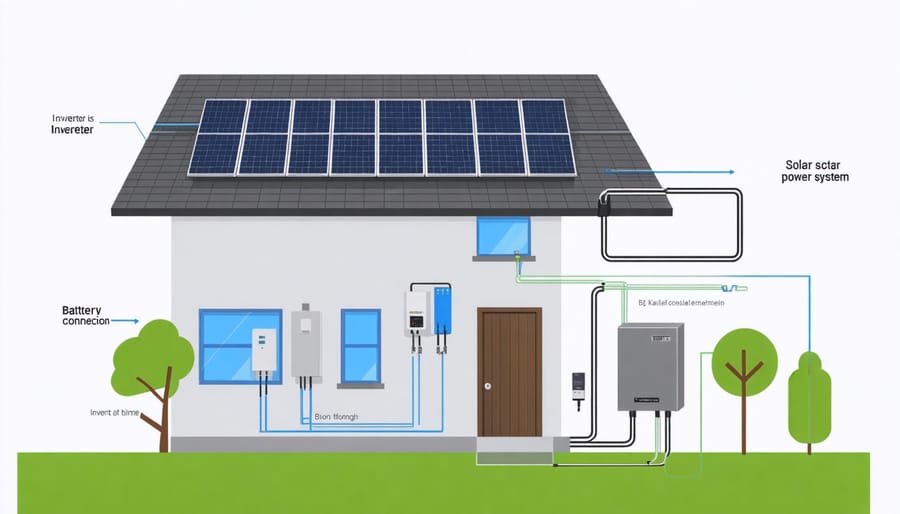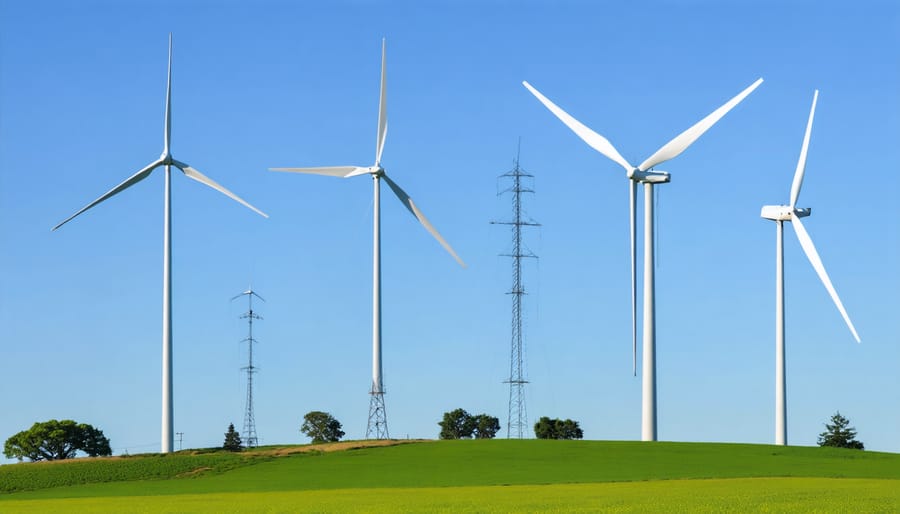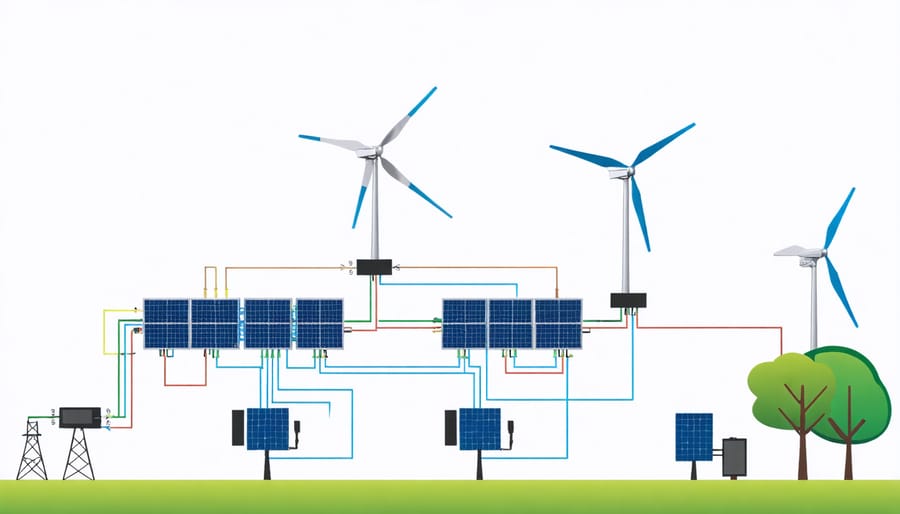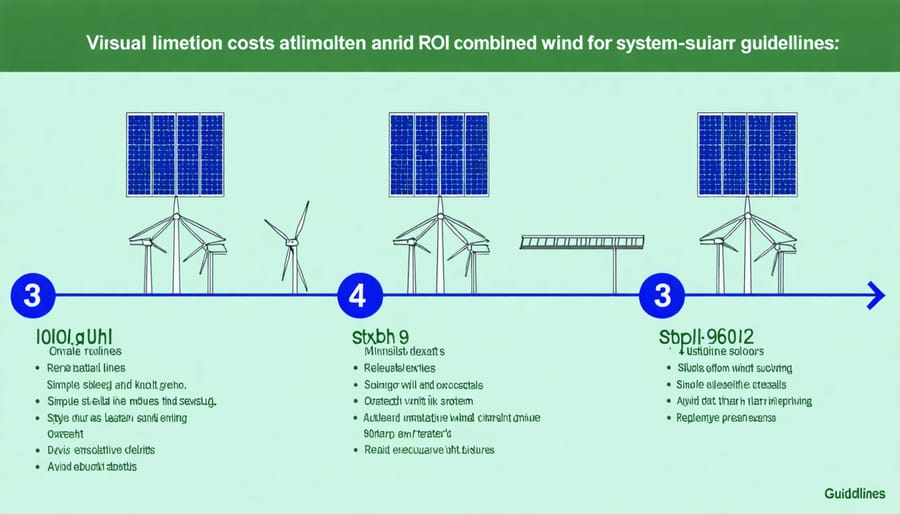Transform your home into a self-sustaining energy hub by harnessing the combined power of wind and solar systems – a proven path toward achieving zero energy homes. Modern hybrid renewable systems can slash electricity bills by 70-90% while providing reliable power throughout day and night cycles, making them increasingly attractive for homeowners seeking energy independence.
Today’s integrated wind-solar solutions offer unprecedented flexibility, with compact roof-mounted wind turbines complementing traditional solar panels to maximize energy generation in varying weather conditions. Recent advances in battery storage technology now enable these systems to power entire homes consistently, even during extended periods of limited sun or wind exposure.
Whether you’re looking to reduce your carbon footprint, protect against rising energy costs, or increase your property value, residential wind and solar power systems represent a smart, future-proof investment. With federal tax incentives covering up to 30% of installation costs and most systems paying for themselves within 5-10 years, there’s never been a better time to make the switch to renewable energy.
Understanding Home Solar Power Systems
Essential Solar System Components
A successful solar power system for your home relies on four key components working together seamlessly. Let’s break down each essential element to help you understand their roles and importance.
Solar panels are your system’s powerhouse, converting sunlight into electricity. These photovoltaic panels come in different sizes and efficiencies, with modern options typically offering 15-20% energy conversion rates. For an average home, you’ll need between 15-25 panels, depending on your energy needs and panel efficiency.
The inverter is your system’s brain, transforming the DC power generated by your panels into AC power that your home can use. You can choose between string inverters (one central unit) or microinverters (one per panel). While microinverters are more expensive, they can increase system efficiency and make it easier to monitor individual panel performance.
Battery storage systems are like your home’s energy savings account. They store excess power generated during sunny days for use during nights or cloudy periods. Modern lithium-ion batteries offer excellent performance and longevity, typically lasting 10-15 years with proper maintenance.
Finally, don’t overlook the importance of your mounting system. These sturdy frameworks keep your panels secure and properly oriented. You can choose between roof mounts (most common), ground mounts (ideal for large properties), or pole mounts (perfect for tracking systems). The right mounting system ensures optimal sun exposure while protecting your roof’s integrity.
When selecting these components, consider factors like your local climate, roof orientation, energy needs, and budget to create the most efficient system for your home.

Solar System Installation Considerations
Before installing solar panels, it’s crucial to evaluate your home’s suitability as part of your overall energy-efficient home design. Your roof’s condition, orientation, and structural integrity play vital roles in maximizing solar energy production.
First, assess your roof’s age and condition. Ideally, your roof should have at least 10-15 years of life remaining, as removing and reinstalling panels for roof repairs can be costly. The ideal roof pitch ranges between 30-45 degrees, though solar panels can be installed on most slopes with proper mounting equipment.
Southern exposure is optimal for solar panels in the Northern Hemisphere, though southeast and southwest-facing roofs can still generate significant power. Consider any potential shading from nearby trees, buildings, or other structures – even partial shade can significantly reduce panel efficiency.
You’ll need approximately 100 square feet of roof space for every 1 kilowatt of solar panel capacity. An average home typically requires between 400-800 square feet for a system that can meet most of its energy needs. Remember to account for setbacks from roof edges and space for maintenance access.
Before installation, have a professional conduct a thorough roof inspection to verify:
– Structural support capability
– Current roof material compatibility
– Presence of obstructions like vents or chimneys
– Local building codes and HOA restrictions
Don’t forget to consider future needs – if you’re planning home additions or nearby tree growth might create shade issues, factor these into your panel placement strategy. A well-planned solar installation will serve your home efficiently for decades to come.
Residential Wind Power Solutions

Wind Turbine Types and Components
When it comes to home wind power, you have two main turbine types to consider: horizontal-axis and vertical-axis turbines. Horizontal-axis turbines are the classic “windmill” style you might picture, with blades that spin perpendicular to the ground. These are typically more efficient but need more space and height. Vertical-axis turbines look more like spinning cylinders and work well in urban areas where wind direction changes frequently.
For home installations, most people opt for small wind turbines rated between 1-10 kilowatts, depending on their energy needs. The key components of any wind turbine system include:
The Rotor: This consists of the blades and hub, which capture wind energy and convert it to rotational force. Most home turbines have 2-3 blades made from durable, lightweight materials like fiberglass or carbon fiber.
Generator: Located inside the turbine housing, this converts the mechanical energy from the rotor into electrical energy. The quality of your generator directly impacts power output.
Tower: Height matters! Your tower needs to place the turbine above nearby obstacles. Most home installations require 30-140 feet towers, with taller towers capturing stronger, more consistent winds.
Controller: This essential component protects your system by regulating speed and preventing damage during high winds. It also manages the power output to your home’s electrical system.
Inverter: Similar to solar systems, the inverter converts the DC power generated by your turbine into AC power your home can use.
Before choosing a system, consider your property’s wind resources, local zoning laws, and available space. A professional assessment can help determine the best turbine type and size for your specific situation.
Site Assessment for Wind Power
Before installing a wind power system, it’s crucial to assess your property’s potential for wind energy generation. The most important factor is your local wind speed – ideally, you’ll need an average wind speed of at least 10 miles per hour throughout the year for a residential wind turbine to be effective.
Start by checking wind resource maps for your area or installing an anemometer to measure wind speeds at your specific location. Keep in mind that wind speeds should be measured at the height where you plan to install your turbine, typically 30-140 feet above ground.
Your property needs enough open space, as turbines require distance from buildings, trees, and other obstacles that could create turbulence. A general rule of thumb is to install your turbine on a tower with its bottom edge at least 30 feet higher than anything within 300 feet.
Local zoning laws and regulations play a crucial role in your site assessment. Check with your municipality about:
– Height restrictions for structures
– Setback requirements from property lines
– Noise ordinances
– Historic district regulations
– Homeowners association rules
Consider your neighbors too – while modern wind turbines are relatively quiet, they’re still visible and may cast moving shadows. It’s good practice to discuss your plans with neighbors early in the process.
Your property’s topography matters as well. Hills, ridges, and open fields typically offer better wind conditions than areas surrounded by tall trees or buildings. The ideal location would be on elevated ground with consistent, unobstructed wind flow.
Remember to evaluate your soil conditions, as your tower will need a sturdy foundation. If possible, choose a spot with good drainage and stable ground composition.
Integrating Solar and Wind Systems
Hybrid System Design
A hybrid wind-solar system combines the best of both renewable energy sources, giving you reliable power throughout the year. These systems work together beautifully – solar panels generate electricity during sunny days, while wind turbines take over during cloudy periods and nighttime hours when the breeze picks up.
The core components of a hybrid system include solar panels, a wind turbine, charge controllers for both power sources, a battery bank, and an inverter. The solar panels are typically mounted on your roof, while the wind turbine stands on a tower in your yard. Both power sources feed into their respective charge controllers, which regulate the power flow to protect your batteries from overcharging.
The battery bank stores excess energy for use when neither wind nor sun is available. The inverter converts the stored DC power into AC power that your home appliances can use. A smart control system manages the power flow between all components, ensuring optimal performance.
One of the biggest advantages of a hybrid system is its reliability. When solar production dips during winter months, wind power often increases to compensate. Similarly, during calm summer days, solar panels pick up the slack. This complementary relationship means you’ll have more consistent power throughout the year.
Consider starting with a smaller hybrid setup and expanding as needed. Many homeowners begin with a few solar panels and a modest wind turbine, then add more capacity as they become comfortable with the technology and their energy needs grow.

Smart Energy Management
Modern smart energy management systems are the brains behind efficient wind and solar power setups. These intelligent controllers help you make the most of your renewable energy by monitoring production, managing storage, and optimizing usage throughout your home.
The heart of these systems is the charge controller, which regulates the power flow between your solar panels or wind turbine and the battery bank. It prevents overcharging and ensures your batteries last longer. For solar-wind hybrid systems, specialized controllers can handle both power sources seamlessly.
Most modern systems come with user-friendly monitoring apps that let you track your energy production and consumption in real-time. You can see exactly how much power you’re generating, using, and storing – right from your smartphone. This visibility helps you make smarter decisions about when to run energy-intensive appliances.
To optimize your system’s performance, consider these strategies:
– Schedule high-energy tasks during peak production hours
– Set up automated controls for non-essential appliances
– Use smart thermostats and LED lighting that adjust automatically
– Configure alerts for system maintenance and weather conditions
Remember, the key to maximizing your renewable energy investment isn’t just about generating power – it’s about using it wisely. With proper management, you can significantly reduce your reliance on the grid while maintaining comfort and convenience.
Cost and ROI Analysis

Initial Investment Breakdown
When planning your renewable energy system, it’s essential to understand the upfront costs involved. For a typical residential solar power system (3-8kW), expect to invest between $15,000 to $25,000 before incentives. This includes solar panels ($5,000-$10,000), inverters ($1,000-$2,500), mounting hardware ($500-$1,500), and professional installation ($3,000-$7,000).
For residential wind turbines, costs typically range from $20,000 to $70,000 for a system capable of powering an entire home. A smaller supplemental turbine might cost $4,000-$8,000. The breakdown includes the turbine itself ($10,000-$40,000), tower and foundation ($5,000-$15,000), and installation ($3,000-$10,000).
Don’t forget about additional expenses like:
– Permits and inspections ($500-$2,000)
– Electrical system upgrades ($800-$2,500)
– Battery storage systems (optional, $5,000-$15,000)
– Site assessment fees ($200-$1,000)
The good news? Federal tax credits can offset 30% of your total system cost, and many states offer additional incentives. Local utility companies might provide rebates or performance-based incentives, making the initial investment more manageable.
Pro tip: Get at least three quotes from certified installers and ask about package deals that combine both wind and solar systems for potentially better pricing.
Long-term Savings Calculator
Want to know exactly how much you can save with a home renewable energy system? Our Long-term Savings Calculator helps you crunch the numbers and make an informed decision. By investing in wind and solar power systems, you can significantly reduce energy bills while contributing to a greener future.
Let’s break down the savings potential:
The average homeowner saves $1,000-$1,500 annually on electricity costs after installing a solar system. Wind turbines can add another $500-$800 in yearly savings, depending on your location and wind conditions. Factor in federal tax credits (currently 30% of installation costs), state incentives, and local utility rebates, and your initial investment becomes much more manageable.
Calculating your payback period is straightforward:
Total System Cost – Tax Incentives = Net Investment
Net Investment ÷ Annual Energy Savings = Years to Break Even
Most homeowners reach their break-even point in 5-8 years for solar and 7-10 years for wind systems. After that, it’s pure savings! Plus, these systems typically last 25-30 years, providing decades of free energy.
Remember to factor in potential increases in electricity rates, which average 2-3% annually. This means your actual savings could be even higher over time. Many homeowners also report increased property values, adding another financial benefit to the equation.
Maintenance and Troubleshooting
Keeping your wind and solar power systems in top condition doesn’t have to be complicated. Like other sustainable home solutions, these systems require regular attention to perform their best.
For solar panels, start with a quarterly cleaning routine. Use soft brushes and mild soap to remove dust, leaves, and bird droppings. Avoid harsh chemicals that might damage the protective coating. During winter, clear snow promptly but gently to maintain efficiency. Check the mounting hardware every six months to ensure everything remains secure.
Wind turbine maintenance includes annual blade inspections for cracks or damage, checking guy-wire tension if applicable, and lubricating moving parts according to manufacturer specifications. Listen for unusual noises – they often signal potential issues that need attention.
Common troubleshooting tips for solar systems:
– If power output drops, first clean the panels
– Check for loose connections in the inverter
– Monitor error codes on your inverter display
– Verify that shade hasn’t developed from growing trees
– Inspect wiring for signs of wear or animal damage
For wind turbines, watch out for:
– Decreased power generation during normal wind conditions
– Unusual vibrations or sounds
– Irregular starting and stopping
– Visible blade damage or imbalance
Keep a maintenance log to track performance and spot trends. Most issues can be resolved through simple fixes, but don’t hesitate to call a professional for electrical problems or anything involving heights. Regular monitoring through your system’s app or display can help catch problems early, saving you time and money in the long run.
Remember to schedule professional inspections every 2-3 years to ensure optimal performance and safety. This preventive approach helps extend your system’s lifespan and maintains its efficiency.
Making the switch to wind and solar power systems is an exciting step toward a more sustainable and cost-effective home. By now, you understand that both solar panels and wind turbines offer unique advantages, and combining them can provide more reliable year-round energy production. The key is to start with a thorough assessment of your property’s potential for both wind and solar resources.
Begin by consulting with local renewable energy experts who can evaluate your site and recommend the most effective system for your needs. Remember that while the initial investment might seem substantial, various incentives, tax credits, and financing options can make these systems more affordable than you might think.
For the best results, consider starting with a small-scale system and expanding as your needs and budget allow. Many homeowners begin with solar panels and add wind power later, or vice versa. Don’t forget to check local regulations and obtain necessary permits before installation.
Regular maintenance will keep your system running efficiently for years to come. Set up a maintenance schedule and familiarize yourself with basic troubleshooting steps. Most importantly, monitor your energy production and consumption to optimize your system’s performance.
By taking these steps toward energy independence, you’re not just reducing your carbon footprint – you’re investing in your home’s future value while potentially eliminating or significantly reducing your monthly energy bills. The path to renewable energy at home is clearer than ever – it’s time to take that first step.
